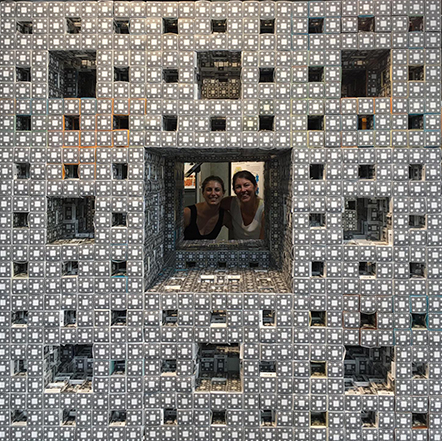The exhibition "Dive into the infinite world of fractals" in Geneva, invited young and old to discover fractals and to participate in the construction of a level 3 Menger sponge. Created from scratch by Sandie Moody high school math teacher and head of Mathscope@large and Elise Raphael SwissMAP Science Officer, the exhibition, which attracted more than 2,200 visitors was originally inspired by a similar project in England. A week before the exhibition ended, we interviewed Sandie Moody.
How was the idea of the exhibition born?
I was looking for outreach activities for Mathscope@large, especially in the numerical analysis field, and I came across the Megamenger project which originated in England completely by chance. I thought that we absolutely had to try since it had not yet been done in Switzerland. And of course, Elise [Raphael] was motivated.
Was the topic chosen randomly or was it something that was important to you?
Mostly by chance and also because we both had some knowledge of fractals and interest in these objects, so it was a perfect fit.
What was the initial target audience for the exhibition?
At the very beginning, the aim was to get help for the construction of a level 3 Menger sponge, because we quickly realised we could not do it alone At the very beginning, the aim was to get help for the construction of a level 3 Menger sponge, because we quickly realised we could not do it alone. That is when we thought we could ask school children in Geneva to help. We didn't even originally plan to have an exhibition room. We just thought that each class could build a piece of the sponge and we would assemble the whole thing. And finally, we had the opportunity to have an exhibition room. So we went ahead and worked to expand the project so that it would be interesting for all audiences.
How do you adapt such a vast and complex subject so that it is suitable for all ages?
Fractals is a mathematical subject that is easy to popularize because it is pretty. The concept is relatively intuitive: we manage to explain the basics in a rather simple way and we can use examples from nature (like the ones shown in the exhibition: ferns, romanesco broccolis, river deltas, etc.). These elements help to make it accessible to audiences that are not necessarily scientific. And we also included a more technical part for those who know a little bit about the subject.
You have received numerous reservations from classes for guided tours (almost 800 pupils from 8 to 18 years old visited the exhibition in three months). In your opinion, what are the reasons for this success?
I think that Covid-19 had an influence. We were able to open the exhibition at the end of the school year when the classes could finally go out, so for many classes it was the only excursion of the year.
That said, even without Covid-19, I think it would have been successful because it's a topic that combines math, art and a manual construction that will leave a memory on students. So even without Covid-19, there was some potential.
If the visitors and the pupils who came were to retain only one thing, what would it be?
The main message is, as always, that math is beautiful, it's pretty and it's not just about calculus.
What is the moment of the exhibition that has marked you the most?
I think the most memorable moment was when we had the opening day, on May 16, the day of the museums in Geneva. The weather was not so good, we had a large crowd of visitors and we were not expecting it at all! It was a nice way to launch the event and for us it was a huge success.
Classes and visitors participated in building this level 3 Menger sponge. A total of 48,000 business cards were used to achieve this goal. It is the biggest and the first one in Switzerland. What will you do with this Menger sponge after the exhibition is over?
We hope to display it in the lobby of the UNIGE Scienscope, in Sciences 2. We'll be looking for other options in the university buildings. And if that's not possible, it will have been an ephemeral piece of art and Switzerland’s first Menger sponge built entirely with business cards!
interviewed by: Joana Mailler
